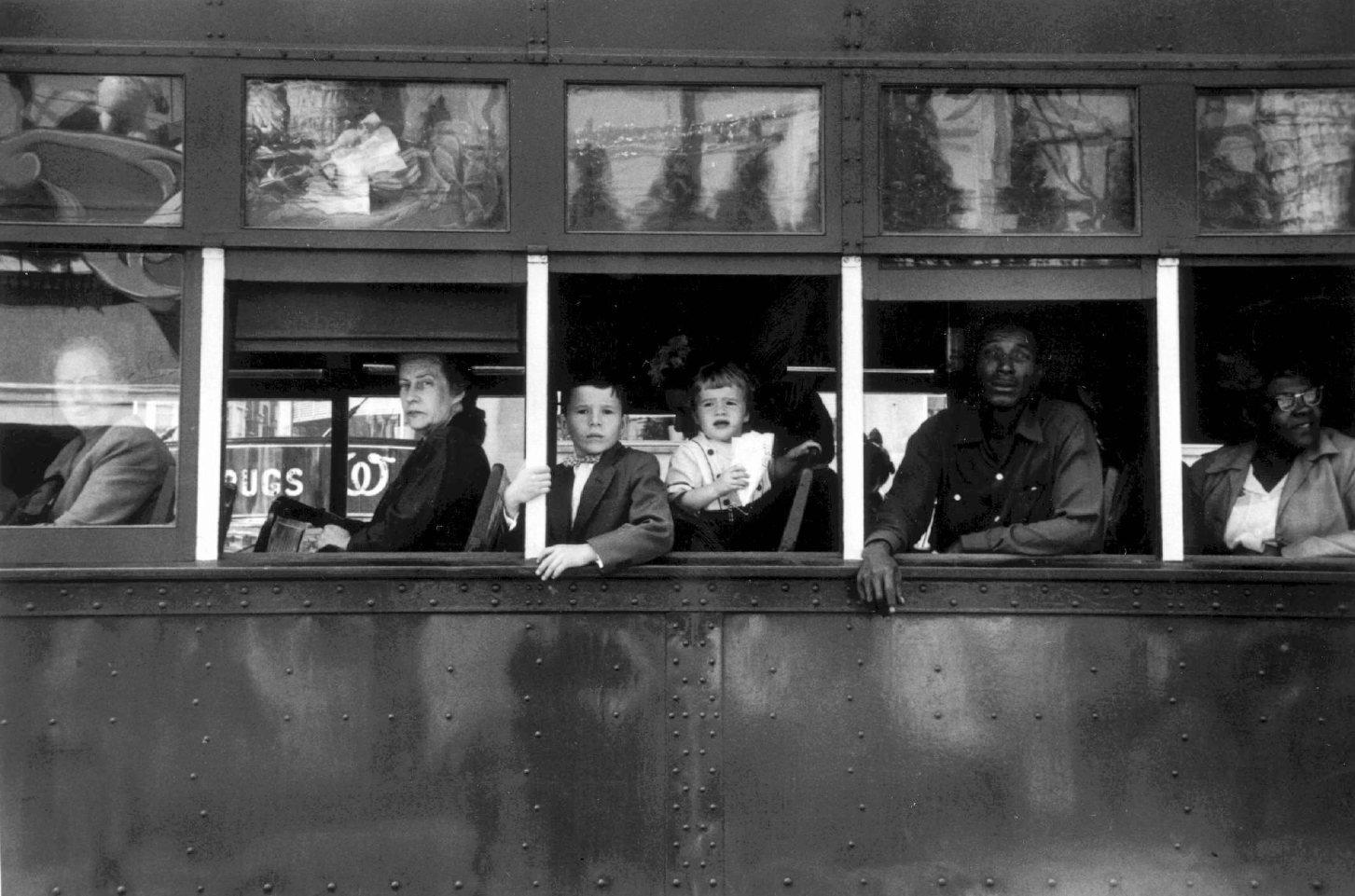Black and White America: The Met Revisits Frank
“Looking In” Pays Tribute to “The Americans,” Which Changed the Landscape of Modern Photography
June 27, 2011

Fifty years after the original exhibition of Swiss-born Robert Frank’s “The Americans,” the Metropolitan Museum of Art elegantly revisits his masterpiece. Contact sheets marked with red circles and dashes, wrinkled work prints, historical information, letters of recommendation and select earlier works give context to the original photographs. The photos, taken during road trips on a 1955 Guggenheim fellowship, are “only partly documentary in nature,” wrote Frank. Despite his straightforward “documentary” style, the images broke ground with their bold representation of all that is dark or dear in American society.
The initial critical response was negative—Frank’s photographs were often dark, strangely angled and overwhelmingly melancholy. Young photographers, on the other hand, embraced the new aesthetic as a benchmark in the life of photography. Susan Kismaric, History of Photography professor and curator of photography at the Museum of Modern Art for over 30 years, explained that the book, “The Americans,” is a consummate work of art that has permanently captured millions. “The [social] issues raised in Frank’s photographs are still relevant today,” said Kismaric.
In the first photograph, the torsos of two women appear in their windows, an American flag adorning the brick façade that separates them. The photograph, “Parade—Hoboken, NJ,” comments on humanity and society not only in the subject matter, but also through symbols, juxtaposition and visual metaphors. The soft details of their flesh and the roughness of the brick suggest intimacy, but their faces are obscured and dominated by shadows and the graphic American flag. By peering into their windows, the viewer prepares to relish Frank’s cropped view of American lives.
From 667 rolls of film, or about 27,000 frames, Frank made 1,000 work prints and eventually chose a string of 83 succinct photographs. “The Americans,” both the original exhibition and its accompanying book, are divided into four parts by an image of an American flag. The Met faithfully fills four rooms with the sections, and one wall summarily proclaims Jack Kerouac’s impression of “the humor, the sadness, the EVERYTHING-ness and American-ness of these pictures.”
As you step into each room, you are greeted by Americans at lunch counters or playing jukeboxes or you find Americans in cemeteries, on the road or in prayer. The walls are neatly lined with a row of photographs that lead you to question the connections between them.
Some symbols reappear from one photograph to the next. A flag of stars and stripes hangs on a wall in “Navy Recruiting Station, Post Office—Butte, Montana,” next to a photograph of stars adorning a bar in “En Route from New York to Washington, Club Car,” followed by a young starlet, lifted like a relief sculpture from a gaudy wall in “Movie Premiere—Hollywood.”
Some photographs share themes, such as race and class. In “Trolley—New Orleans,” a trolley’s side windows frame, from front to back, a white man with his face obscured, a white woman looking disdainful, two bored white children, a black man pleading with his eyes and an elderly black woman looking backwards. The anniversary exhibition placard explains that this photographwas taken just days before Rosa Park’s famous bus arrest.
“City Fathers—Hoboken, NJ,” “Political Rally—Chicago,” and later, “Store Window—Washington, D.C.,” share a political theme, yet are stylistically distinct. The hats and expressions of “City Fathers” are comical, the man in “Political Rally” stands on a precipice with only the shadow of his fist and the eerie “Store Window” displays a tuxedo for sale on a headless mannequin next to a campaign portrait of former President Dwight D. Eisenhower. The photographs, with their varied moods and subject matters, show ordinary people and celebrities as commodities to be consumed. The juxtaposition of cultural idols suggests radical similarities.
Formal relations between photographs also achieve cohesion through contrast. Bright glares of light, textured darkness and grain, and odd frames and perspectives have an almost pattern-like sequence. Gestures and rhythm are seen in human form as hands reach out in desperation and candid subjects advertise blank stares. Mysteriously distant, yet startlingly apparent, the symbols and subjects repeated in “The Americans” are dizzying, grounding and enhanced by 50 years of retrospection. Three black men lean on cars with their hands over their mouths in “Funeral – St. Helena, South Carolina,” revealing the persistent, haunting silence of many of Frank’s Americans.
Later, three crosses stand before a beam of light in “Crosses on Scene of Highway Accident—U.S. 91 Idaho.” Nearby, a robed man carries a white cross through an expansive landscape in “Mississippi River, Baton Rouge” and a cross-carrying statue is silhouetted by foggy parking lots in “St. Francis, Gas Station and City Hall—Los Angeles.” The photographs, already ostensibly religious in subject, explore spiritual transcendence through qualities of light and calmness in angle, frame and exposure.
Frank’s photographs capture ethereal light, despairing darkness, oft-blurred subjects and an unorthodox view of American culture that led to an ultimately compelling social critique. The photographs, as well as Frank’s unconventional photographic approach, illuminate many issues that were once concealed in American society. From problems of social and racial strata to spiritual and moral struggles, the raw, sometimes strange qualities of his images captured a silence that speaks profoundly of its zeitgeist. In hindsight, the eerie charm of the photographs is treacherous, as modern audiences move, hypnotized, through rooms lined with Frank’s Americans.









